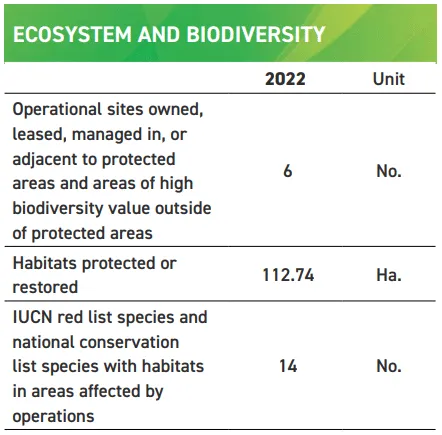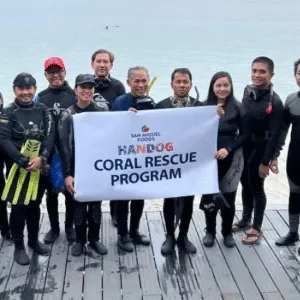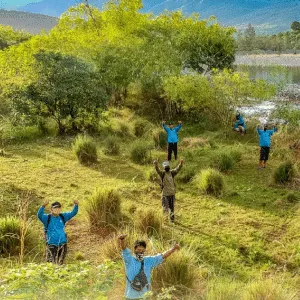Biodiversity and Ecosystems
Our country is one of the most biodiverse places in the world, with at least 20,000 wildlife species which cannot be found anywhere else. Thus, conserving our ecosystems and protecting their natural habitats from significant threats should be of utmost importance, not only for the government, but also for the private sector.
In the recently held 27th UN Conference of the Parties (COP27) in Egypt, nature-based solutions were included in UN Climate negotiations for the first time. COP27 “emphasizes the importance of protecting, conserving and restoring nature and ecosystems to achieve the Paris Agreement temperature goal, including through forests and other terrestrial and marine ecosystems acting as sinks and reservoirs of greenhouse gases and by protecting biodiversity, while ensuring social and environmental safeguards.”
We strongly support and welcome this positive development. We commit to the responsible conduct of our businesses to ensure that we maintain the balance of nature and that we give priority to the preservation and restoration of our natural ecosystems. We have stepped up our sustainability initiatives through multiple environmental protection and biodiversity conservation efforts.

In 2022, we had six operational sites in the Group that were based in or adjacent to protected areas or areas of high biodiversity value. These were Petron’s Bawing and Amlan terminals, GSMI’s DBI, SMGP’s Masinloc and Ilijan power plants, and SMHC’s LCWD.
Petron’s Bawing Terminal is located along the Sarangani Bay Protected Seascape, which is a proclaimed National Integrated Protected Area System (NIPAS) and also classified as a Category V Protected Area by the International Union for Conservation of Nature (IUCN). To protect the site, we developed and implemented a 10-year biodiversity conservation plan that covers 91,737 m2 of foreshore area along the seascape. The plan focuses on preventing and managing any environmental (e.g., water pollution and habitat destruction) and socioeconomic (e.g., alternative livelihood) issues that may arise. We review and update this plan every 10 years or less, depending on the need, to account for developments in the area and changes in regulations.
Meanwhile, Petron’s Amlan Terminal is adjacent to the Tañon Strait Protected Seascape, which is the largest Marine Protected Area in the Philippines. To help protect the site as well as the other coastlines and coastal areas where Petron’s operations are located, Petron has created “Puno ng Buhay,” a forest restoration and mangrove conservation program in partnership with the DENR and our host LGUs. Under this initiative, we adopt mangrove reforestation sites with the goal of protecting critical watersheds and minimizing our carbon footprint. We also train the residents of our neighboring coastal areas on how to grow and take care of mangrove forests, with the hope of providing them with an additional source of livelihood. As of 2019, we have adopted a total of 30 hectares of mangrove reforestation areas in Tacloban City, Leyte and Roxas City, Capiz, which resulted in more than 1,000 tons of sequestered carbon.
GSMI’s DBI facility is located along the coastline of the Guimaras Strait, which is identified as a Biodiversity Conservation Site in Western Visayas by the DENR. In the mid-1990s, we established a mangrove reforestation area along the coastline where the distillery is located. Now measuring close to 12 hectares, the mangrove forest has an excellent survival rate of 96%, proving the area has remained healthy. These mangroves were also planted to contribute to the conservation of the natural biodiversity of the Guimaras Strait and to reduce the risk of flooding and soil erosion. We also conduct tree planting activities in the area every year.
We will safeguard the well-being of the natural habitats and ecosystems where we operate. We will continue to work with others toward a world where biodiversity is valued and conserved.
Furthermore, we constantly monitor Guimaras Strait’s coastline to ensure that the surrounding area is always kept clean. One of GSMI’s longest-running biodiversity conservation activities is regular coastal cleanups in collaboration with LGUs and volunteers from nearby communities.
SMGP’s Masinloc Power Plant is situated along Oyon Bay, a protected landscape and seascape by virtue of the Expanded NIPAS Act; while the Ilijan Power Plant is located by the Verde Island Passage, which is recognized as the center of global shore-fish biodiversity. SMGP has developed a biodiversity management system that safeguards the ecosystems around these protected areas. We have long-standing partnerships with environmental experts, government agencies, and local communities that implement tree planting, mangrove reforestation, and coral rehabilitation projects. One of our biggest initiatives is Project 747, which aims to plant over 7 million upland and mangrove trees over 4,000 hectares of land in at least seven provinces nationwide.
Lastly, SMHC’s LCWD is near the Angat Watershed Forest Reserve, which protects the drainage basin in the southern Sierra Madre range north of Metro Manila. SMHC completed the planting of over 26,000 trees in Angat, Bulacan together with the town’s Dumagat communities. In partnership with the Dumagats, SMHC was able to cover the first 16 of 55 hectares targeted for planting with dipterocarp tree species like white and red lauan, palosapis, apitong, yakal, guijo, and other indigenous species such as bignai and narra. This initiative is part of SMGP’s Project 747. Furthermore, we also partnered with Metropolitan Waterworks and Sewerage System (MWSS) to launch an annual Million Tree Planting Challenge to replenish the forest cover of 126 hectares of the Angat Dam Watershed within three years. Under this challenge, our employees have planted 6,400 trees (including 3,200 Narra and Guyabano tree varieties) over 14 hectares at the Angat Dam Watershed since 2019.
In the coming years, we will implement more large-scale changes with both the private sector and the government to help halt biodiversity loss. We will safeguard the well-being of the natural habitats and ecosystems where we operate. We will continue to work with others toward a world where biodiversity is valued and conserved.



